My husband, Jerry, and I and our three sons, Wolf, 16, Hayden, 14 and Finis, 9, are just starting our “Epic Europe Family Adventure.”
This trip is a dream-come-true that we have been dreaming about, planning and saving for for some time. Our adventure is 28 days long and includes this itinerary: London, Munich, Germany (via Paris, France), Lauterbrunnen and Zermatt, Switzerland, Italy’s Moneglia and Cinque Terre, Pisa, Florence and Rome, and then Portugal.
First, we drove from our home in Lander, Wyoming, to Denver, CO., where we made a quick visit with my Grandma, and then we visited Jerry’s brother, Jamie, who dropped us off at the airport for our direct flight to London.

The flight was an 8-hour flight that took off at 7:45pm. After in the air, we let the boys watch one movie, then we all closed our eyes ’till we landed in London, which given the 7-hour jump ahead in time, meant we had feet on the ground in Europe at 11:30am on Monday, May 23.
Once in London, we were greeted by my friend, Antonia, whom I met on my Brooks Range Alaska NOLS course in 2011. Antonia has visited us in Lander, WY for the famous 4th of July, during her Yellowstone Park visits. Now, we would see her on her turf! (She’s from Germany, but teaches Sanskrit at a private school in London.)
It was so great to see Antonia, who led us to the Underground, and traveled to a station near our hotel on Gower Street. We loved that our room number was “1.” How perfect for the start of our adventure. We also loved the quaint comfort of our hotel room, which was exactly one room with 5 beds in it – one for each of us. We found this to be charming in its practicality.
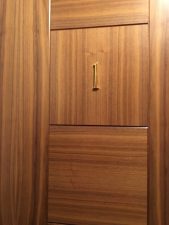
Our room number for our first hotel on the trip: 1.
Tired from our hours of travel, which included our 5-hour drive from Lander, WY to Denver, CO, and then 8-hour international flight during the night, and add to that we were suddenly on a clock that was 7 hours ahead of our usual (US Mountain Standard Time) schedule, we were not exactly full of energy. So we all relaxed in our hotel room for a couple of hours and visited with Antonia, before venturing to the British Museum.
We intentionally planned a mellow first day in London because we knew we’d be tired, and we planned to not do what we felt like, which was collapse on the hotel beds for a nap. (Our friends and family who have traveled to Europe advised against taking a nap, suggesting we should instead resist napping and try to fall into step with the local time)
We planned to explore at a lazy pace a small portion of the British Museum, which was just a couple of blocks from our hotel, and then get some dinner at a pub, before watching The Taming of the Shrew, at the historic outdoor Globe Theatre.
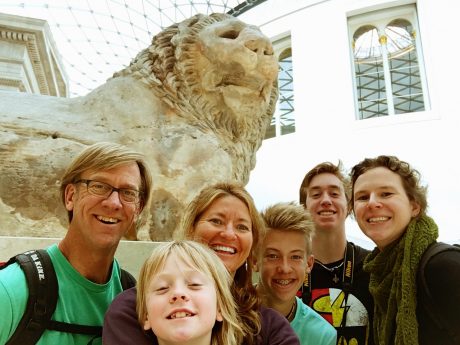
The British Museum, which offers free admission, was a treat, and that is an understatement! Rick Steves calls it the “Chronicle of Western Civilization,” and his description is apt. There is no way we could adequately review all the museum has to offer, so we focused on just a few areas. We explored much of the museum, but we especially enjoyed seeing the Elgin Marbles, the original Rosetta Stone, and the many Egyptian statues and artifacts.
The Elgin Marbles, known to the world as the Parthenon Marbles, are a collection of Classical Greek marble sculptures (made by the citizens of Athens under the supervision of the renowned architect and sculptor Phidias and his assistants), inscriptions, and architectural pieces that were originally part of the temple of the Parthenon and other buildings on the Acropolis of Athens. Thomas Bruce, 7th Earl of Elgin obtained in 1801 a controversial permit from the Sublime Porte, which then ruled Greece.


Part of the Elgin Marbles, this naked man reclines on a rock, cushioned by the skin of a feline animal. He is probably Dionysos, god of wine. (His missing right hand perhaps held a cup of wine?)

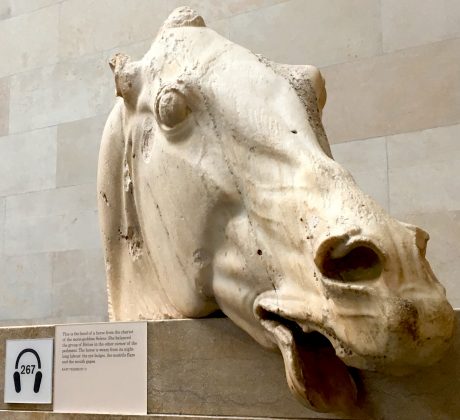
Well, I think if all we had time for were the Elgin Marbles, that would have been pretty astounding in itself. The boys and I really loved looking at all of them, and reading and learning about them. It’s something else to imagine the work, the skill and craftsmanship, and the commitment required to carve such beautiful sculptures from stone, and to see them some 2,500 years later.
Well, I think if all we had time for were the Elgin Marbles, that would have been pretty astounding in itself. The boys and I really loved looking at all of them, and reading and learning about them. It’s something else to imagine the work, the skill and craftsmanship, and the commitment required to carve such beautiful sculptures from stone.
Next up was the original, 5,000-year-old Rosetta Stone. The Rosetta Stone holds the key to understanding Egyptian hieroglyphs and is a script made up of small pictures that was used originally in ancient Egypt for religious texts.

The boys especially loved Room 4, the Egyptian sculptures. There are many. In fact, the British Museum holds the largest collection of Egyptian objects that are outside of Egypt.
We first explored mummies, which includes actual corpses and displays of the history, and process of of mummifying. Especially fascinating is the 5,000-year-old sand-dried mummy.

The statue of King Ramesses II was carved from a single block of stone, and is the upper part of a colossal seated statue. The sculpture weight 20 tons (40,000 pounds!), and was transported on sleds over land and In a purpose-built boat down the Nile.
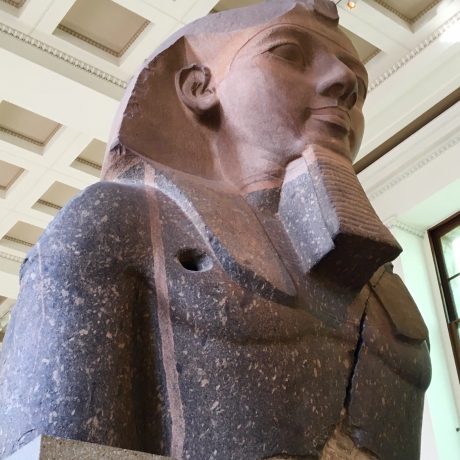
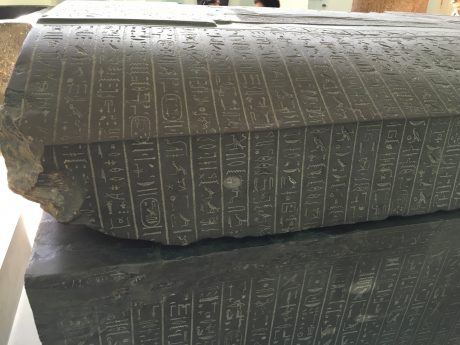
After the British Museum, we found a British pub, where Jerry, Antonia and I enjoyed a cold one, and we all ate a pretty tasty pub meal.
Fed and feeling recharged, we caught the Underground and then walked to the historic Globe Theater. Seeing The Taming of the Shrew was a treat for me that the family agreed to. I was full of anticipation to see the Shakespeare play for the first time, and to see it in Shakespeare’s original venue. The Globe is an oak-and-thatch replica of the original Elizabethan theatre, showing Shakespeare plays in the open air.

The play was epic! Jerry and the boys were generous in agreeing to include the play on our itinerary, since I was the only one enthused about it. But, to my pleasant surprise, the boys loved it. It woke them up, and I even caught Fin, our 9-year-old, laughing out loud throughout the play. The cast was fantastic, and the setting was unbeatable, making the entire experience of watching the play a 10 out of 10. I highly recommend attending a Shakespeare play in the open air, outdoor Globe Theater.
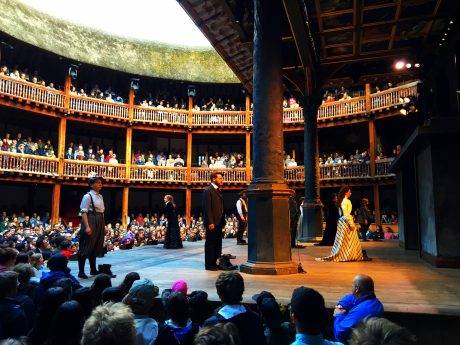
We were exhilarated by the play, especially the second act, which was even more spectacular than the first. As we made out way out of the theater and walked to the Underground station, we stopped to take in a beautiful reflection of the awe-inspiring St. Paul’s Cathedral in the River Thames. We then walked across a bridge and right up to the Cathedral before we found our transport.
According to Wikipedia, St Paul’s Cathedral, London, is an Anglican cathedral, the seat of the Bishop of London, and the mother church of the Diocese of London. It sits on Ludgate Hill at the highest point of the City of London. Its dedication to Paul the Apostle dates back to the original church on this site, founded in AD 604.
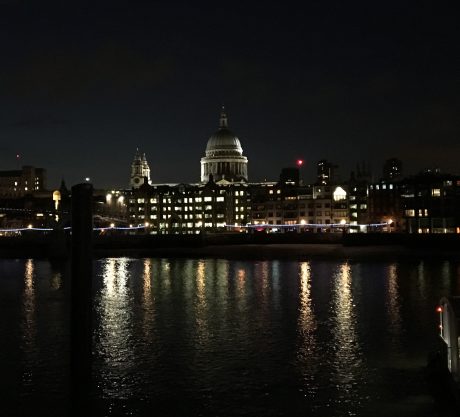
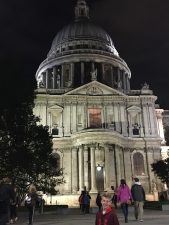
The present church, dating from the late 17th century, was designed in the English Baroque style by Sir Christopher Wren. The cathedral is one of the most famous and most recognizable sights of London. Its dome, framed by the spires of Wren’s City churches, dominated the skyline for 300 years. At 365 feet high, it was the tallest building in London from 1710 to 1962. The dome is among the highest in the world. St Paul’s is the second largest church building in the United Kingdom, second only to Liverpool Cathedral.
We made it back to the hotel at around 11:30pm and pretty much collapsed into immediate sleep. If our first day and evening’s events were any indication, this dream-come-true, 28-day adventure in Europe was going to be nothing short of epic…
Thanks for reading, and please stay tuned for more posts here as we make our way through Munich, Germany, Lauterbrunnen and Zermatt, Switzerland, Italy’s Cinque Terre National Park, Pisa, Florence and Rome, and Lisbon and Lagos, Portugal.
(See London Day 2 blog post)